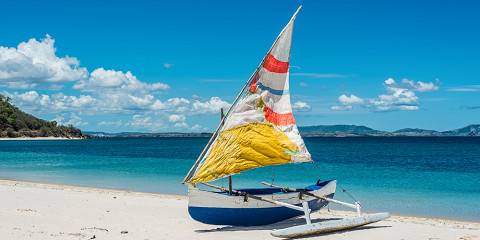Andasibe-Mantadia National Park is one of Madagascar’s premier parks and comprises two separate protected areas: Analamazaotra National Park and Mantadia National Park. Analamazaotra (also known as Andasibe) is the country’s most popular park and the more accessible. It’s home to the largest lemur species, the teddy-bear-like indri. Their incredibly noisy wailing call will stay with you forever. Mantadia, 20km/12mi farther north, is less visited but worth the day trip for its primary forest and birdlife.

-
Best Time To Go
- April, May, October and November (Best weather, less rain)
-
High Season
- July, August and December holidays (The park is busy)
-
Size
- 163km² / 63mi²
-
Altitude
-
800-1,233m /2,625-4,045ft
 View Photos
View Photos
 View Photos
+24
Photos
View Photos
+24
Photos
Pros & Cons
- Accessible from the capital city of Antananarivo (Tana) and the village of Andasibe
- Excellent chance of seeing the indri, Madagascar’s largest lemur
- Numerous hiking circuits, from easy to difficult
- Night walks to see nocturnal species are possible in neighboring private reserves
- Good accommodations options around Andasibe village
- An opportunity to see rare primary forest in Mantadia
- High-altitude rainforest is often cold and wet
- Some trails get very busy in high season
- There are no accommodations around the Mantadia section of the park
Wildlife
There are 12 different lemur species in the area: six are visible by day and six are visible by night. Aside from the indri, which is best seen in the morning, by day you might observe family groups of the beautiful diademed sifaka. At night, spotting colorful chameleons, frogs and mouse lemurs by torch is a great experience. You might even see Goodman’s mouse lemur, which was only discovered in 2005.
More about Andasibe-Mantadia’s wildlifeScenery
The Andasibe section of the park comprises mid-altitude mountain rainforest. Here, and in some of the smaller private reserves alongside the main park, the canopy is so thick that sunlight barely reaches the forest floor. Also recommended is a visit to the Mantadia part of the park, with its pristine primary forest of huge trees reaching into the sky. You might see flowering orchids from October to December or January.
Activities
Guided walks are the main activity in the two sections of the park and in the neighboring reserves. A list of trails, with their cost and duration, are posted at each entrance. Guided night walks are not possible inside the national parks, but they can be done in the adjacent private reserves or along the main road outside the park. Guided visits to the village of Andasibe are also worthwhile.
Weather & Climate
The park has a cool, wet climate. You can experience rain throughout the year, but the Wet season (November to April) has the highest rainfall. During these months, temperatures reach up to 28°C/82°F during the day and the humidity is extremely high. Cyclones are possible from January to March. The cooler months of the Dry season (May to October) see daytime temperatures around 24°C/75°F, with nights as cold as 9°C/48°F.
More about the weather and climateBest Time To Visit
You can visit Andasibe-Mantadia throughout the year. The shoulder months of April, May, October and November are particularly nice as the weather is mild and there isn’t too much rain, although the rains can arrive in late November. Animals, including reptiles, that are less active in the cooler, drier months from June to September are more active and easier to spot during the shoulder months. In October and November, you might see lemur babies. The wettest months from January to March are best avoided.
More about the best time to visit



